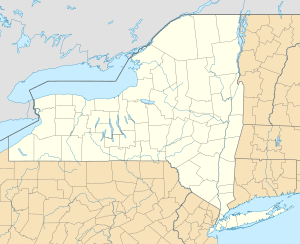Elizabeth A. Morton National Wildlife Refuge facts for kids
Quick facts for kids Elizabeth A. Morton National Wildlife Refuge |
|
|---|---|
|
IUCN Category IV (Habitat/Species Management Area)
|
|
 |
|
| Location | Suffolk County, New York, United States |
| Nearest city | Noyack, New York |
| Area | 187 acres (76 ha) |
| Established | 1954 |
| Governing body | U.S. Fish and Wildlife Service |
| Website | Elizabeth A. Morton National Wildlife Refuge |
The Elizabeth A. Morton National Wildlife Refuge is a special place in Noyack, New York. It covers about 187-acre (76 ha) of land and water. This refuge is mostly on a narrow piece of land, like a finger, that sticks out into Noyack Bay and Little Peconic Bay. It's a protected area where wildlife can live safely.
The United States Fish and Wildlife Service helps manage this refuge. It's part of a bigger group of protected lands called the Long Island National Wildlife Refuge Complex.
Contents
Discover Elizabeth A. Morton National Wildlife Refuge
This amazing refuge was created on December 27, 1954. A kind person named Elizabeth Alexandra Morton donated the land to protect nature.
A Home for Many Habitats
The refuge has many different kinds of natural areas. These include sandy bay beaches and ponds with slightly salty water, called brackish ponds. There are also freshwater ponds and unique bowl-shaped holes in the ground called kettle holes.
You can also find muddy areas called tidal flats and grassy salt marshes. There are also freshwater marshes, areas with shrubs, grasslands, and forests. These forests have trees like oak and red cedar. All these different habitats are super important for the wildlife on Long Island.
Wildlife Wonders and Migration
The refuge's shape, pointing north and south, is perfect for many animals. It's especially helpful for birds like shorebirds, raptors (birds of prey), and songbirds. They use the coastline here as a guide when they fly long distances during their yearly migration.
Nesting Birds and Sea Turtles
Along the beaches, you might see special birds building their nests. These include the piping plover, roseate tern, least tern, and common tern. These birds need quiet, safe places to lay their eggs and raise their young.
The waters around the refuge are also very important for young Kemp's ridley sea turtles. These are very rare sea turtles! Sometimes, you might even spot loggerhead sea turtles swimming here too.
Winter Visitors
When the weather gets colder, many different kinds of waterfowl come to the refuge. These are birds that love water, like ducks and geese. You're most likely to see birds such as Long-tailed ducks, white-winged scoters, goldeneyes, and black ducks during the winter months. They come here to find food and shelter from the cold.



